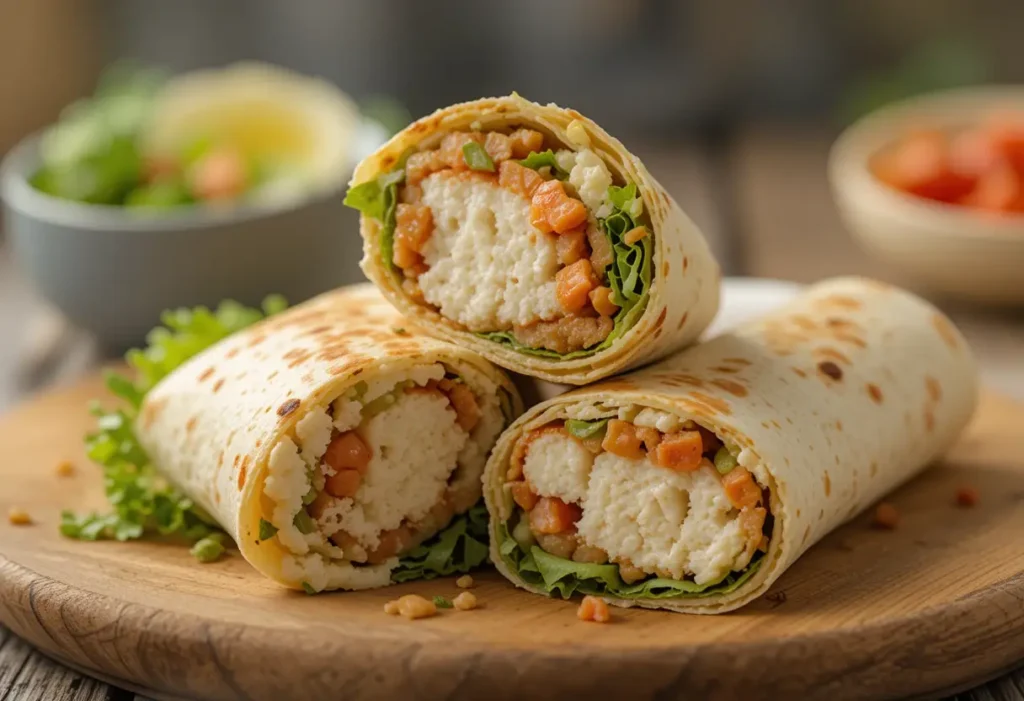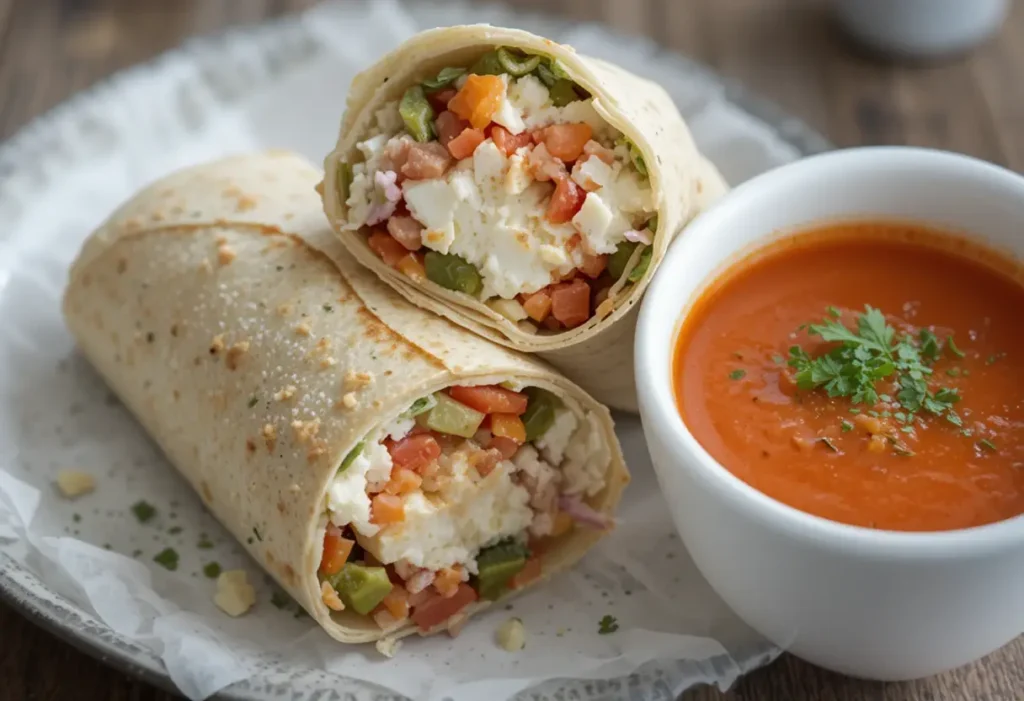A cottage cheese wrap is a delicious, versatile, and nutritious meal option that combines the creamy goodness of cottage cheese with a variety of fresh vegetables, herbs, and wraps. Perfect for a quick lunch or a light dinner, cottage cheese wraps are celebrated for their adaptability to different dietary preferences and tastes.
Historical Origins of Cottage Cheese Wraps
The origins of cottage cheese wraps are not precisely documented, but they are likely rooted in the fusion of modern dietary trends with traditional culinary practices. Cottage cheese, a staple ingredient in many cultures, has been used in wraps as part of the growing interest in high-protein, low-fat meals. The wrap concept itself traces back to ancient flatbreads, which were used to encase fillings for portable meals.
Table of Contents
Benefits of Cottage Cheese in Your Diet
Nutritional Value of Cottage Cheese
Cottage cheese is a powerhouse of nutrition. It is rich in:
- Protein: Supports muscle repair and growth.
- Calcium: Essential for bone health.
- Phosphorus: Plays a role in energy production.
- B Vitamins: Aid in metabolism and red blood cell production.
Additionally, it is low in fat and calories, making it an excellent choice for those looking to maintain a balanced diet.
Health Benefits of Regular Consumption
Incorporating cottage cheese into your diet can lead to several health benefits:
- Weight Management: Its high protein content keeps you feeling full longer.
- Muscle Building: Ideal for post-workout recovery due to its amino acid profile.
- Digestive Health: Contains probiotics (in some varieties), supporting gut health.
- Bone Strength: The calcium and phosphorus content helps maintain strong bones and teeth.
Essential Ingredients for Cottage Cheese Wraps
Types of Cottage Cheese for Wraps
- Regular Cottage Cheese
- Quantity: 1 cup
- Best for a creamy and rich flavor. Suitable for traditional wraps.
- Low-Fat or Non-Fat Cottage Cheese
- Quantity: 1 cup
- Ideal for those watching their calorie intake while maintaining high protein levels.
- Flavored Cottage Cheese (e.g., herbed, spiced)
- Quantity: 1 cup
- Adds pre-mixed flavor without needing extra seasoning.
Recommended Vegetables and Herbs
- Cucumber
- Quantity: ½ cup (thinly sliced or diced)
- Adds crunch and hydration to the wrap.
- Bell Peppers (red, yellow, or green)
- Quantity: ½ cup (thin strips)
- Provides sweetness, crunch, and a dose of vitamin C.
- Shredded Carrots
- Quantity: ¼ cup
- Brings a hint of natural sweetness and a vibrant color.
- Spinach or Lettuce Leaves
- Quantity: 1 cup (loosely packed)
- Acts as a base layer, adding a fresh, leafy texture.
- Avocado (optional)
- Quantity: ½ medium avocado (sliced)
- Adds creaminess and healthy fats to the wrap.
- Herbs:
- Dill: 1 tablespoon (finely chopped)
- Parsley: 1 tablespoon (finely chopped)
- Basil: 1 tablespoon (chopped or torn)
- Chives: 1 teaspoon (chopped)
Choice of Wraps: Whole Grain vs. Gluten-Free Options
- Whole Grain Wraps
- Quantity: 2 large wraps (8-10 inches in diameter)
- Rich in fiber, providing a hearty and nutty base for your filling.
- Gluten-Free Wraps (e.g., almond flour, rice flour, or cassava-based)
- Quantity: 2 large wraps (8-10 inches in diameter)
- Suitable for those with gluten sensitivities or dietary restrictions.
By carefully selecting and measuring these ingredients, you can ensure your cottage cheese wraps are both delicious and perfectly balanced!
Step-by-Step Recipe for Cottage Cheese Wraps
Preparing the Filling
- Gather Ingredients:
- 1 cup cottage cheese (your choice: regular, low-fat, or flavored).
- ½ cup diced cucumber.
- ½ cup thinly sliced bell peppers (red, yellow, or green).
- ¼ cup shredded carrots.
- 1 cup loosely packed spinach or lettuce leaves.
- 1 tablespoon chopped fresh herbs (e.g., dill, parsley, or chives).
- Optional: ½ medium avocado (sliced), a pinch of salt, pepper, and seasonings (garlic powder, paprika).
- Mix the Ingredients:
- In a large bowl, combine the cottage cheese, diced vegetables, and herbs.
- Add a pinch of salt, pepper, or other preferred seasonings to taste.
- Mix gently but thoroughly to ensure even distribution of ingredients.
Assembling the Wraps
- Lay Out the Wrap:
- Use 2 large wraps (whole grain or gluten-free) and place them flat on a clean surface or plate.
- Add the Filling:
- Spoon the prepared cottage cheese mixture evenly across the center of each wrap.
- Leave about 1 inch of space around the edges for easy folding.
- Optional Additions:
- Add slices of avocado, a drizzle of olive oil, or sprinkle sunflower seeds for extra flavor and texture.
- Fold the Wrap:
- Fold the bottom edge upward, followed by the sides inward.
- Roll tightly from the bottom to the top, securing the filling inside.
Cooking Techniques and Tips
- Serve Fresh:
- For a cool and refreshing option, serve the wrap immediately without additional cooking.
- Lightly Toast the Wrap:
- Heat a non-stick skillet over medium heat. Place the assembled wrap seam-side down in the pan.
- Toast each side for 2-3 minutes or until golden brown and slightly crispy.
- Grill the Wraps:
- Preheat a grill pan or outdoor grill. Lightly oil the surface to prevent sticking.
- Grill each side of the wrap for 2-3 minutes to achieve char marks and enhance the smoky flavor.
- Pack for Later:
- Wrap tightly in foil or parchment paper for a portable meal option. Keep refrigerated if not eaten immediately.
Enjoy your delicious, healthy, and customizable cottage cheese wraps, perfect for any meal of the day!
Variations of Cottage Cheese Wraps
Vegan and Vegetarian Alternatives
- Vegan Alternatives:
- Replace cottage cheese with vegan ricotta or silken tofu blended with lemon juice for a creamy texture.
- Add roasted chickpeas, hummus, or mashed avocado for protein and flavor.
- Vegetarian Enhancements:
- Incorporate additional vegetables like roasted zucchini, grilled eggplant, or sautéed mushrooms.
- Add hard-boiled egg slices or crumbled feta cheese for extra protein and richness.
Low-Calorie Cottage Cheese Wrap Ideas
- Focus on Fresh Veggies:
- Increase the quantity of fresh, low-calorie vegetables like spinach, lettuce, cucumber, and bell peppers.
- Use Low-Fat Cottage Cheese:
- Opt for low-fat or non-fat cottage cheese to reduce calorie intake without compromising protein.
- Swap the Wrap:
- Use lettuce leaves or collard greens instead of traditional wraps for a low-carb, low-calorie alternative.
- Flavor Smartly:
- Use spices like paprika, chili flakes, or garlic powder instead of calorie-dense sauces or dressings.
Serving and Presentation Tips
How to Serve Cottage Cheese Wraps
- Plated Presentation:
- Slice the wrap diagonally for a clean, appealing look.
- Arrange the halves on a plate with the filling exposed to showcase the vibrant colors.
- Party Platters:
- Cut wraps into bite-sized pieces and secure with toothpicks for a finger-food option.
- Meal Prep:
- Wrap tightly in foil or parchment paper and refrigerate for a quick grab-and-go meal.
Pairing with Sauces and Sides
- Sauces for Dipping:
- Tzatziki Sauce: A refreshing cucumber-yogurt blend that pairs well with the creamy cottage cheese.
- Avocado Dip: Mashed avocado with lime juice and cilantro for a creamy, tangy side.
- Hummus: A protein-rich option to enhance flavor.
- Side Dishes:
- Salad: A simple side salad with mixed greens, cherry tomatoes, and a light vinaigrette complements the wrap.
- Soup: Pair with a warm bowl of tomato or vegetable soup for a comforting meal.
- Chips or Crackers: Add baked whole-grain chips or gluten-free crackers for crunch.
With these variations and serving ideas, your cottage cheese wraps can suit any dietary preference, occasion, or presentation style!
Storing and Reheating
Best Practices for Storing Leftovers
- Wrap Securely:
- Use airtight containers or tightly wrap the cottage cheese wraps in plastic wrap or aluminum foil to prevent air exposure.
- Refrigerate Promptly:
- Store leftovers in the refrigerator within 2 hours of preparation to maintain freshness.
- Keep wraps in a designated container to avoid absorption of other odors from the fridge.
- Shelf Life:
- Consume refrigerated wraps within 2-3 days for optimal taste and safety.
- Freezing Option:
- Wraps with minimal fresh vegetables (e.g., spinach) can be frozen for up to 1 month. Use freezer-safe bags and defrost overnight in the refrigerator before reheating.
Tips for Reheating Without Losing Flavor
- Skillet Reheating:
- Heat a non-stick skillet over medium heat and warm the wrap for 2-3 minutes on each side. This method helps restore crispness.
- Microwave Method:
- Wrap the cottage cheese wrap in a damp paper towel and microwave on medium power for 30-60 seconds. This prevents dryness.
- Oven Reheating:
- Preheat the oven to 350°F (175°C). Wrap the wrap in aluminum foil and heat for 10 minutes.
- Avoid Sogginess:
- If reheating, avoid wraps with high-water-content vegetables (e.g., cucumbers) as they may release water and make the wrap soggy.
Common Mistakes to Avoid
Ingredient Dos and Don’ts
- Do:
- Use fresh and high-quality ingredients for the best flavor and texture.
- Incorporate a variety of vegetables and herbs for balanced nutrition and taste.
- Don’t:
- Overfill the wrap, as it can tear or become difficult to roll.
- Use watery vegetables like tomatoes or cucumbers without patting them dry to avoid making the wrap soggy.
Common Cooking Errors
- Overcooking:
- Avoid toasting or grilling wraps for too long, as it can cause them to dry out and become brittle.
- Improper Folding:
- Ensure the wrap is folded tightly and securely to prevent the filling from spilling out.
- Uneven Cooking:
- When grilling or toasting, flip the wrap evenly to avoid burnt spots or uneven heating.
- Skipping Seasoning:
- Failing to season the cottage cheese or vegetables can result in bland flavors. Always taste and adjust seasonings before assembling.
By following these tips and avoiding common mistakes, you can ensure your cottage cheese wraps remain fresh, flavorful, and perfectly prepared every time!
FAQs About Cottage Cheese Wraps
Can I freeze cottage cheese wraps?
Yes, you can freeze cottage cheese wraps, but with a few considerations:
- Preparation for Freezing: Avoid using fresh vegetables with high water content (e.g., cucumbers or tomatoes) as they may become soggy when thawed.
- How to Freeze: Wrap the cottage cheese wraps tightly in plastic wrap or foil and store them in a freezer-safe bag or container.
- Shelf Life: Frozen wraps can be stored for up to 1 month. Defrost in the refrigerator overnight before reheating.
Are cottage cheese wraps suitable for kids?
Absolutely! Cottage cheese wraps are a nutritious and kid-friendly option:
- Customization: You can tailor the ingredients to suit your child’s preferences, such as using mild vegetables or adding a sprinkle of cheese.
- Nutrition: Cottage cheese is a great source of protein and calcium, essential for growing children.
- Portion Size: Use smaller wraps or cut larger wraps into halves or bite-sized pieces for easier handling.
How many calories are in a typical cottage cheese wrap?
The calorie count of a cottage cheese wrap depends on the ingredients used:
- Base Wrap: Whole grain wraps are typically 150–200 calories, while gluten-free wraps may vary.
- Filling: 1 cup of low-fat cottage cheese has about 200 calories.
- Vegetables: Most fresh vegetables add minimal calories, around 10–50 calories depending on the quantity.
- Total Calories: A standard cottage cheese wrap usually ranges from 300–400 calories, depending on additional toppings or sauces.
What are the best seasonings for cottage cheese wraps?
Seasonings can enhance the flavor of cottage cheese wraps significantly. Here are some popular options:
- Herbs: Dill, parsley, basil, cilantro, or chives for a fresh, aromatic touch.
- Spices: Paprika, garlic powder, onion powder, chili flakes, or black pepper for depth and mild heat.
- Citrus: A splash of lemon or lime juice can brighten the flavors.
- Blends: Try Italian seasoning, taco seasoning, or za’atar for unique flavor profiles.
Alternatives for cottage cheese if unavailable?
If cottage cheese is unavailable, you can use these alternatives:
- Ricotta Cheese: Offers a similar creamy texture with a slightly sweeter taste.
- Greek Yogurt: Thick and tangy, it works well as a substitute in savory wraps.
- Hummus: Provides a creamy, protein-rich option with added flavor.
- Mashed Avocado: Creamy and nutritious, it pairs well with vegetables and herbs.
- Silken Tofu: Blend with seasonings to mimic the texture and taste of cottage cheese.
These FAQs cover the most common concerns and offer helpful tips to ensure your cottage cheese wraps are a hit for every occasion!
Conclusion
Cottage cheese wraps are a delicious, healthy, and highly customizable meal option. Whether you’re preparing a quick and easy snack or experimenting with different creative wrap fillings, they can suit every palate and occasion. For more inspiration, check out our Ultimate Guide to Mastering the Grilled Chicken Wrap Recipe or explore exciting flavor combinations with our Shrimp Burrito: The Perfect Wrap Guide. Embrace the versatility of wraps today and make your next meal a masterpiece!



